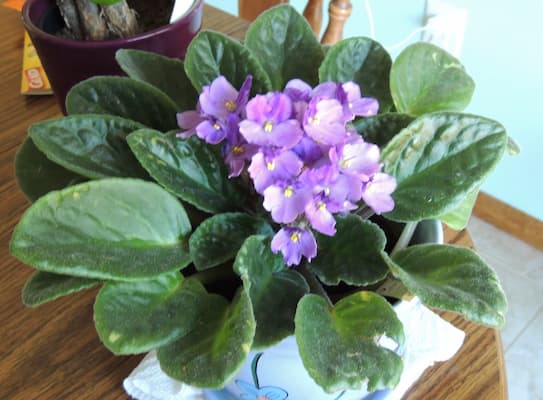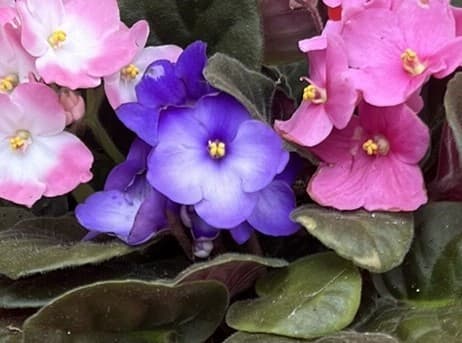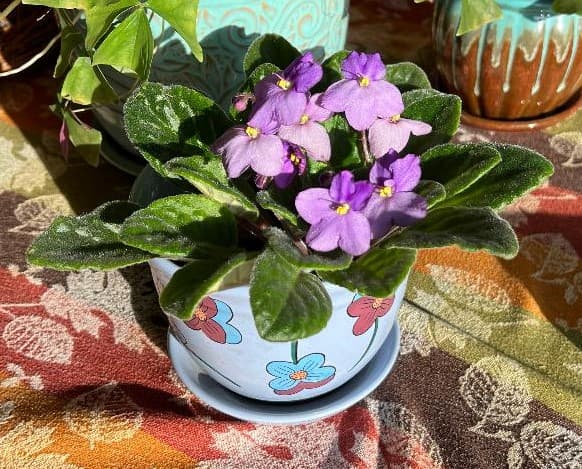How to Grow African Violets as Houseplants

Growing African Violets Indoors
African Violets are relatively easy to grow. The plants are native to wooded coastal regions of East Africa. They are an ideal indoor houseplant. It is one of the more popular indoor house plants. Their sometimes shy blooms are long-lasting, often lasting for several weeks. The biggest problem with growing them, is sometimes they don’t bloom. So, you may have to coax them into blooming. We’ve got pointers to help you force African Violets to bloom.
The plants are perennials. With the proper care, they will live and thrive in your home for many years.
African Violet Plant Specifics
Flower Colors: Blue, Pink, Purple, Red, Violet, White
Flowers Bloom: Indoors, any time of year if forced to bloom.
Plant Height: 6 – 9 inches tall, 6 – 9 inches wide.
Life Span: 20 or more years
Hardiness Zones: 11 – 12
Soil Type: Use specifically formulated, rich African Violet potting soil.
Ideal Soil pH: 5.8 – 6.5
Botanical Name: Saintpaulia ionantha

Forcing African Violets to Bloom
Are your African Violet plants refusing to bloom? It’s a frequent problem. Here are the key steps for forcing African Violets to bloom:
- Provide ample sunlight. Use full, direct to indirect sunlight. Without enough sunlight, your plants will not bloom.
- Provide even moisture. The soil should be moist, not wet at all times. Also, water from the bottom.
- Do not use cold water. Rather, use room temperature water.
- The plants like higher humidity. Add a humidifier to the room.
- Add a fertilizer high in phosphorous. This is the key element to promote blooms in plants. Make repeated applications if necessary.
- If you are having trouble forcing them to bloom, avoid high nitrogen fertilizers.
Garden Tip: Use a soil tester to monitor nutrient levels.
Propagating African Violet Plants
Like other flowers, African Violets can be propagated from seeds. You can harvest seeds from your flowering plants. The seeds come from the spent blooms. However, seed production doesn’t always occur. As a result, growers most often obtain them from a reputable seed supplier.
Home growers most often propagate new plants by taking young leaves and root them. Cut a healthy leaf off of the plant where the leaf stem meets the main stem. put the leaf in a small glass and fill it with just 1/2 to 1 inch of water. Do not immerse the leaf itself, as it will rot. After the roots have formed, plant it into a flowerpot with fresh potting soil.
Tip: Root and pot a few new plants and give them to friends.
Step by Step how to Propagate African Violet Plants from Leaf Cuttings.

Choosing the Right Flowerpot
Choosing the right flowerpot is important when growing African Violets. First, it needs to be attractive. There are an amazing variety of flowerpots to choose from. Select a color and style that fits your tastes and blends well with the decor of your room. A flowerpot with a drainage hole is also important. Make sure the flowerpot has a saucer underneath to capture excess water.
Now most often plants need room to spread their roots. It’s just the opposite with your African Violet plant. Select a pot about the diameter of the foliage. The plants are more likely to bloom if it is slightly rootbound. Repot them every four to six months with fresh African Violet soil mix.
African Violet Care
African Violet care starts with lots of sunshine. Grow this plant in bright, indirect light. Place them in a sunny window but avoid hot rays coming in during the summer months. Also, avoid placing them near frosty windows in the winter months. Provide artificial lighting, if little sunshine is available.
Soil and Fertilizers: Most garden stores carry an African Violet soil mix and fertilizers, which have been formulated specifically for these plants. The fertilizers are higher in phosphorus to help promote blooming. Fertilize the plants every 3-4 weeks. For indoor plants, use a liquid fertilizer. Or, use fertilizer spikes which deliver nutrients slowly over an extended period of time.
Watering: Avoid overwatering them. Use a planter with openings at the bottom, to allow good drainage. Always water them from the bottom up, and never let the leaves get wet. They like their water warm, not cold. If watering from the top, be careful not to get water on the leaves, as they will spot. Water the plants every three days, if they need it.
Temperatures: The ideal temperature is 75 degrees during the day and 60- 70 degrees at night. Also, they like higher humidity levels. Add a humidifier during dry winter months.
Pruning and Plant Appearance: Trim off dead or unhealthy leaves. Remove spent flower blooms. Deadheading spent blooms will promote even more blooms for you to enjoy.
Dusting Plant Leaves: All indoor houseplants are susceptible to dust accumulation on their leaves. Do not use a wet or damp cloth to remove dust. Water can spot and damage the leaves. Instead, use a soft-bristled brush to gently wipe the dust off the leaves. Also, you might have success with a gentle breeze on the leaves.
African Violet Insect Problems
Insect pests for these plants include spider mites and mealy bugs. Apply insecticides or insecticidal soaps as needed.
African Violet Disease Plant Problems
Powdery mildew, evident by a white powdery substance on the leaves, and other fungal diseases can occur. Treat the plant early with a general-purpose fungicide.
The plants suffer crown rot and rot and stem rot from too much water.
Brown spots or leaf scorch is caused by too much hot, direct sunlight.
Burnt or dry-looking leaves are an indication of too little moisture in the soil.
Drooping leaves are a sign of too little moisture in the soil., or low temperatures.
Also See: Plant Problems – causes and cures
Related Articles
Plant Problems –See the causes and cures.
More on Forcing African Violets and other plants to Bloom Indoors
Please support our site. Shop for:
- rmmatthews100@hotmail.com
- 585-721-6528
- Rochester, NY
©1999-2024 GardenersNet.Com, All Rights Reserved

